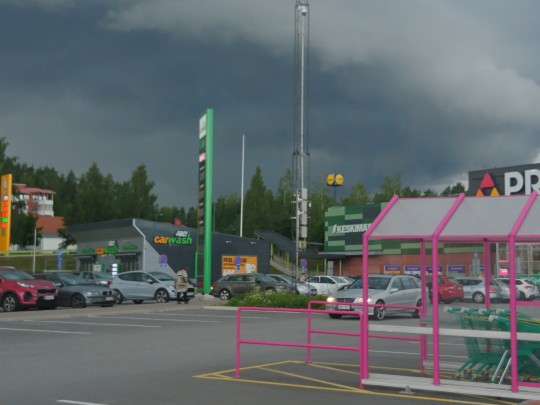#electric grids
Text
Excerpt from this New York Times story:
Federal regulators on Monday approved sweeping changes to how America’s electric grids are planned and funded, in a move that supporters hope could spur thousands of miles of new high-voltage power lines and make it easier to add more wind and solar energy.
The new rule by the Federal Energy Regulatory Commission, which oversees interstate electricity transmission, is the most significant attempt in years to upgrade and expand the country’s creaking electricity network. Experts have warned that there aren’t nearly enough high-voltage power lines being built today, putting the country at greater risk of blackouts from extreme weather while making it harder to shift to renewable sources of energy and cope with rising electricity demand.
A big reason for the slow pace of grid expansion is that operators rarely plan for the long term, the commission said.
The nation’s three main electric grids are overseen by a patchwork of utilities and regional grid operators that mainly focus on ensuring the reliability of electricity to homes and businesses. When it comes to building new transmission lines, grid operators tend to be reactive, responding after a wind-farm developer asks to connect to the existing network or once a reliability problem is spotted.
The new federal rule, which was two years in the making, requires grid operators around the country to identify needs 20 years into the future, taking into account factors like changes in the energy mix, the growing number of states that require wind and solar power and the risks of extreme weather.
Grid planners would have to evaluate the benefits of new transmission lines, such as whether they would lower electricity costs or reduce the risk of blackouts, and develop methods for splitting the costs of those lines among customers and businesses.
The commission approved the rule by a 2-1 vote, with the two Democratic commissioners in favor and the lone Republican, Mark Christie, opposed. Mr. Christie said the rule would allow states that want more renewable energy to unfairly pass on the costs of the necessary grid upgrades to their neighbors.
Nationwide, energy companies have proposed more than 11,000 wind, solar and battery projects, but many are in limbo because there’s not enough capacity on the grid to accommodate them. What’s more, individual developers are currently required to pay for grid upgrades to accommodate their projects in a process that is piecemeal and slow.
Some critics say that’s like asking a trucking company to pay for an additional lane on a highway that all motorists ultimately use. A better approach, they say, would be to plan ahead for broad upgrades with the costs shared by a wide set of energy providers and users.
But the question of who pays for those grid expansions has sparked furious debate.
9 notes
·
View notes
Text
A Really Good Podcast On Fusion, Renewables, Decarbonization, and Politics
#David Roberts#volts.wtf#Podcasts#NeoRadio#Electricity Generation#Renewable Energy#Solar Power#Wind Power#Electric Grids#Politics#informative reblogs
6 notes
·
View notes
Text
Stormy weather



2 notes
·
View notes
Text
The global Synchronous Condenser Market is projected to grow from USD 661 million in 2022 to USD 811 million by 2030, at a CAGR of 2.6%, according to a new report by MarketsandMarkets™. Synchronous condensers ensure a stable supply to the transmission grid. They can also supply and absorb reactive power and deliver voltage support and dynamic regulation. In addition, many renewable resources are remotely located and feed power into a single radial line. Synchronous condensers can be installed close to the connection point to strengthen the grid with additional short-circuit power. This improves the fault ride-through capability of the power installation itself and provides additional voltage stability. With renewable power generation on the rise, the market for synchronous condensers is expected to witness substantial growth in the coming years. This trend is expected to gain traction in North America and Europe, where renewable energy is gaining momentum, and the conventional power generation infrastructure is aging and converted to synchronous condensers.
#synchronous condenser#synchronous condensers#synchronous condenser market#energy efficiency#energy#energia#power generation#utilities#power#utility#electricity#renewable power#renewableenergy#renewable resources#power infrastructure#power grid#smart grid#power grids#electric grids#power distribution#power transmission#hvdc#electrical grid#Electrical Utilities#electric grid#Electric Utilities
0 notes
Text
Integration of Solar Energy into Electric Grids 2023
Solar energy is rapidly overtaking fossil fuels as the primary source of energy across Europe. With a target of over 600 GW of total installed solar capacity by 2030, Europe’s electricity network must be ready to accommodate the exponential growth of solar energy and enable faster decarbonization. In order to optimize the integration of solar photovoltaic (PV) systems into the grid, the solar and…

View On WordPress
0 notes
Text
Chicago, Aug. 14, 2023 (GLOBE NEWSWIRE) -- The global Grid-forming Inverter Market is projected to grow from USD 680 million in 2023 to USD 1,042 million by 2028, at a CAGR of 8.9% according to a new report by MarketsandMarkets™.
#power grid#grid-forming inverter#grid forming inverter market#energy#power#electricity#power generation#utilities#electric utilities#renewable energy#renewable#grid forming inverters#electrical grid#smart grids#smart grid#electric grids#power grids#grids#electrical grids#transmission grid#electrical utilities#utilities industry#utility#renewable power#renewables#wind energy#wind power#wind#wind power plant#solar energy
0 notes
Text
2 HP Washdown Motor - Frame: 184TC - RPM: 1200

View the 2 HP Washdown Motor - Frame: 184TC - RPM: 1200. Phoenix Phase Converters offers reliable phase converters and electrical transformers.
#electric motors#motors#motor#electricity#infrastructure#electric grids#electric utilities#electrical#voltage converters#voltage stabilizer#voltage#industrial engineering#industrial goods#industrial#commercial property#commercial#equipment
0 notes
Text

#Greg Abbott the butcher of Texas#Tex-ass Republicans are the worst#Trump sycophants#Cancun Cruz#Dan Patrick sacrificed your grandparents to Covid#Texas electric grid failure#Texas is a failed third world state#republicans ruined Texas#republican assholes#republican hypocrisy#corporate greed#republican party#never trump#traitor trump#crooked donald
514 notes
·
View notes
Text
Absolutely losing my mind over Scar’s stream today
He was already talking to Etho while catching ocelots
Joel logs in and Scar immediately asks if Etho wants to go visit him
We get so many Etho lore crumbs (although he doesn’t fully confirm anything except having stubble and trying to get rid of 2 extra house generators)
They hang out for like 2 hours doing nothing hut chatting
Eventually Scar leaves but forgot that he left his ocelots at Etho’s because he was so excited about boat boys that he never brought them home
#ethoslab#goodtimeswithscar#smallishbeans#boat boys#hermitcraft#there was so much more as well and I already want to rewatch the streams bc ads kept trying to interrupt the lore#both joel and gem told etho they wanted a generator and he told them they had to pick it up but couldn’t tell them where#he also might live in the middle of nowhere off the grid and has to chop wood for electricity#he also may or may not have a phone but hinted at probably not#but somehow managed to get fast internet#to be clear none of what he said surprised me one bit#he also retold the same story of his voice being recognized so is that still the only time#i find it hard to believe but also he is probably the closest to an actual hermit irl of anyone on the server
520 notes
·
View notes
Text

#photography#dimitri djuric#art#2020s#energy#power#culture#electric#infrastructure#photos#aesthetic#night#electrical grid#engineering#technology#light#science#electricity#power grid#communication#⚡ ⚡ ⚡
2K notes
·
View notes
Text
hell state 🙃
176 notes
·
View notes
Text










Callum's "Skye"
#art#design#luxury cars#luxury car#car concept#concept#car#off-road#off-grid#ian callum#skye#e-car#sportcars#sportcar#render#ev#ev cars#ev car#electric vehicles
47 notes
·
View notes
Text
/PRNewswire/ -- Oil Immersed Power Transformer Market is expected to reach USD 28.3 billion by 2028 from USD 21.2 billion in 2023 at a CAGR of 6.0% during the 2023–2028 period according to a new report by MarketsandMarkets™.
#Oil Immersed Power Transformer#Oil Immersed Power Transformer Market#Oil Immersed#power transformer#power transformers#energy#energia#power#power generation#utilities#electricity#utility#power transmission#grids#power grid#power distribution#electrical grid#electric grids#power grids#transmission and distribution#transformers#Transformer
0 notes
Text
Maryland’s top utility regulator was watching the news one February morning when a headline blindsided him: Two suspects with neo-Nazi ties had been charged with plotting to take down Baltimore’s power grid.
Jason Stanek, the then-chair of the state’s Public Service Commission, said Maryland regulators were “caught flat-footed,” not hearing a word from law enforcement before the news broke — or in the months afterward. Federal prosecutors have alleged the defendants were driven by “racially motivated hatred” to try to cut power to hundreds of thousands of people in the state’s largest city, which has a predominantly Black population.
The FBI declined to comment on its communications with the Maryland commission. But Stanek’s experience is not uncommon.
A POLITICO analysis of federal data and interviews with a dozen security, extremism and electricity experts revealed that despite a record surge in attacks on the grid nationwide, communication gaps between law enforcement and state and federal regulators have left many officials largely in the dark about the extent of the threat. They have also hampered efforts to safeguard the power network.
Adding to the difficulties, no single agency keeps a complete record of all such incidents. But the attacks they know about have regulators and other power experts alarmed:
— Utilities reported 60 incidents they characterized as physical threats or attacks on major grid infrastructure, in addition to two cyberattacks, during the first three months of 2023 alone, according to mandatory disclosures they filed with the Department of Energy. That’s more than double the number from the same period last year. DOE has not yet released data past March.
— Nine of this year’s attacks led to power disruptions, the DOE records indicate.
— The U.S. is on pace to meet or exceed last year’s record of 164 major cyber and physical attacks.
— And additional analyses imply that the true number of incidents for both 2022 and 2023 is probably even higher. POLITICO’s analysis found several incidents that utilities had reported to homeland security officials but did not show up in DOE data.

According to a report on grid security compiled by a power industry cyber clearinghouse, obtained by POLITICO, a total of 1,665 security incidents involving the U.S. and Canadian power grids occurred last year. That count included 60 incidents that led to outages, 71% more than in 2021.
While that report does not break down how many of those incidents occurred in which country, the U.S. has a significantly larger grid, serving 145 million homes and businesses, with nearly seven times Canada’s power-generating capacity.
Law enforcement officials have blamed much of the rise in grid assaults on white nationalist and far-right extremists, who they say are using online forums to spread tactical advice on how to shut down the power supply.
Concerns about the attacks have continued in recent months, with incidents including a June indictment of an Idaho man accused of shooting two hydroelectric stations in the state.
But law enforcement officers investigating alleged plots against the grid don’t necessarily alert the Energy Department or other regulatory bodies.
“We have no idea” how many attacks on the grid are occurring, said Jon Wellinghoff, a former chair of the Federal Energy Regulatory Commission, which regulates the U.S. electric grid. “It looks like they’re escalating if you look at the data. But if you don’t have enough data, you can’t discern patterns and proactively work to stop these things from happening.”
Wellinghoff was FERC’s chair when an unknown sniper attacked a Pacific Gas and Electric substation in San Jose, Calif., in 2013 — an incident regulators have described as a “wake-up call” on the electricity supply’s vulnerability to sabotage.

Last year’s record number of physical and cyber disruptions to the U.S. power system included several incidents that captured public attention, such as a December shooting attack against two North Carolina substations that left 45,000 people without power for four days. The state’s medical examiner has blamed the attack for the death of an 87-year-old woman who died after her oxygen machine failed, ruling it a homicide. Nobody has been charged.
“There is no doubt there’s been an uptick over the last three years in the amount of incidents and also the severity of the incidents,” said Manny Cancel, senior vice president at the North American Electric Reliability Corp., the nonprofit body in charge of setting reliability standards for the bulk power system. He is also CEO of its Electricity Information Sharing and Analysis Center, which gathers and analyzes data from power companies.
Cancel said NERC has “seen two pretty substantial increases” in incidents coinciding with the 2020 and 2022 election cycles.
Grid attacks that led to power outages increased 71% from 2021 to 2022, totaling 55 incidents in 2022, according to a NERC briefing to utilities that POLITICO obtained. That increase was primarily due to a rise in gunfire assaults against critical infrastructure.
The largest outage reported from a physical attack early this year — which occurred in March in Clark County, Nev. — affected more than 11,000 people, according to DOE data.
But the state Public Utilities Commission was not aware of any outage due to an attack occurring that day, spokesperson Peter Kostes told POLITICO by email. That’s even though state regulations require utilities to contact the commission within four hours of a significant outage.
The state’s largest utility, NV Energy, said in a statement that it had reported the incident to local law enforcement “as soon as we learned about this incident ... so we can continue to increase our resilience against ongoing threats to the energy industry.” A spokesperson for the utility did not respond to multiple requests for comment on whether it had informed the commission.
Federal regulations also require utilities to report cyber or physical attacks to DOE, including physical attacks that cause “major interruptions or impacts” to operations.
They must also tell the department about disruptions from weather or other causes that meet certain criteria, such as those that cut off service to more than 50,000 customers for at least an hour, an uncontrolled loss of more than 200 megawatts of power, or a utility voluntarily shutting more than 100 megawatts, according to an Energy Department spokesperson. The spokesperson provided the information on the condition that they not be identified by name.
The Energy Department’s records don’t include at least seven reported physical assaults last year and this year that the Department of Homeland Security and the affected utilities said caused substantive economic damage or cut off power to thousands of customers. POLITICO found these incidents by cross-checking the department’s data against warnings issued by DHS and the FBI’s Office of the Private Sector.
DOE said the incidents may not meet its reporting thresholds.
Several of the incidents missing from DOE’s data involved clear physical attacks, based on other agencies’ descriptions. But the utilities involved said they did not report the incidents to the department because the attacks did not affect the kind of major equipment that could lead to widespread, regional power failures.
One of the incidents not found in DOE’s records cut off power to about 12,000 people for roughly two hours in Maysville, N.C., after a shooting damaged a substation in November, according to a DHS report. The FBI’s investigation into the incident is ongoing, according to the intelligence agency.
The utility affected by the incident, Carteret-Craven Electric Cooperative, reported the incident to NERC’s Electricity Information Sharing and Analysis Center, but didn’t report the attack to DOE because it was a “distribution-level” incident, said Melissa Glenn, a spokesperson for the utility. That means the outages caused by the damage would have been limited to local power customers and not lead to the wider blackouts federal regulators are most concerned with.
In another case unreported to the Energy Department, a substation owned by the East River Electric Cooperative serving the Keystone oil pipeline in South Dakota was attacked by gunfire late at night in July 2022, according to DHS. The incident caused more than $1 million in damage and forced the pipeline to reduce operations while repairs were underway.
East River co-op spokesperson Chris Studer said the utility reported the incident to local law enforcement, which brought in the FBI. East River also reported the incident to NERC and its E-ISAC, along with regional grid agencies, but said it did not report it to DOE because the attack did not affect the bulk power system.
Brian Harrell, a former assistant secretary for infrastructure protection at DHS, said in an email that utilities have too many competing agencies to report to, and suggested reporting be streamlined to NERC’s E-ISAC.
“This lack of consistency, by no fault of the utility, suggests that the numbers may not paint a complete picture,” he said.
Grid experts said these data gaps clearly indicate a lack of understanding about which agencies utilities need to report to and when.
Utilities may be using a “loophole” based on definitions of what constitutes “critical infrastructure,” said Jonathon Monken, a grid security expert with the consulting firm Converge Strategies. He was previously senior director of system resilience and strategic coordination for the PJM Interconnection, the nation’s largest power market.
There are “lots of ways” to work around DOE requirements, Monken added, but as he reads the regulation, utilities are required to report any operational disruptions caused by a physical attack.
“[I]t appears the information you collected shows that companies are still missing the boat when it comes to mandatory reporting,” he said. “Not good.”
One former FERC official who was granted anonymity to speak about a sensitive security issue said the commission also received no alerts from law enforcement officials about the planned and actual attacks that took place last year. That omission hinders agencies’ ability to respond to these kinds of events, the person said.
A spokesperson for FERC declined to comment on the commission’s communications with law enforcement.
But Cancel defended government agencies’ response to these incidents, and said federal investigators may have had specific intelligence reasons for keeping FERC and state utility agencies out of the loop.
“I’m not a lawyer or a law enforcement professional, but you had an active criminal investigation going on,” he said. “I don’t think they wanted to sort of blow the horn on that and compromise the integrity of the investigation.”
An FBI spokesperson offered no direct response to these criticisms in an email, but said the agency “views cybersecurity as a team sport.” The person commented on the condition that the remark be attributed to the bureau.
The FBI urged utility executives last month to attend security training hosted by intelligence agents in order to ensure they are up to speed on the threats posed by bad actors.
“We can’t do it without you,” Matthew Fodor, deputy assistant director of the FBI’s counterterrorism division, said during an all-day FERC technical conference on Aug. 10. “The challenges that we have — and DOE can probably speak to this better than anybody — is limited resources.”
People attacking the electricity supply have thousands of potential targets, including power substations and smaller but critical pieces of utility infrastructure. The smaller pieces often go unprotected because federal standards do not require utilities to secure them.
Nearly half of the 4,493 attacks from 2020 to 2022 targeted substations, according to the NERC briefing from February, making them the most frequent targets for perpetrators over that period.
Details on how to carry out these kinds of attacks are available from extremist messaging boards and other online content, researchers and federal security officials say. These include maps of critical entry points to the grid, along with advice that extremists have gleaned from incidents like the assault in North Carolina.
Stanek, the Maryland electricity regulator, said he was “disappointed with the level of coordination and communication” that federal and state law enforcement displayed in handling the alleged plot in Baltimore. No trial date has been announced for the case, which is in U.S. District Court in Maryland.
Maryland’s Public Service Commission is in charge of ensuring that the state’s power system keeps the lights on. Regulators need to be kept informed of threats to the system so they can coordinate with other agencies in case an attack succeeds, Stanek said.
At the same time, he quipped, maybe he was better off in the dark after all.
“There’s a lot of colorful details in [the FBI report],” Stanek said. He paused, thinking. “And honestly, as a regulator, had I received these details in advance and shared the information with trusted sources within state government, I would have had sleepless nights.”
“So perhaps the feds did a favor by only sharing this information after everything was all said and done,” he added.
#us politics#news#politico#2023#alt right#domestic terrorists#neo nazis#fbi#power grids#power outages#Department of Energy#canada#white nationalists#Federal Energy Regulatory Commission#US electric grid#North American Electric Reliability Corp.#Department of Homeland Security#Office of the Private Sector#counterterrorism#cybersecurity#utility infrastructure#maryland
75 notes
·
View notes
Text
The global power grid market is expected to grow from an estimated USD 282.1 billion in 2023 to USD 367.4 billion by 2028, at a CAGR of 5.4% during the forecast period.
#power grid#power grids#power grid market#energy#power#power generation#power transmission#power distribution#smart grids#electrical grid#smart grid#electrical grids#electric grids#grids#electricity#utilities#electric utilities#renewable energy#renewable#transmission and distribution
0 notes
Text
15 HP Washdown Motor - Frame: 215T - RPM: 3600

View the 15 HP Washdown Motor - Frame: 215T - RPM: 3600. Phoenix Phase Converters offers reliable phase converters and electrical transformers.
#electric motors#motors#power supply#power grid#power surge#power#electricity#infrastructure#electric grids#voltage converters#voltage stabilizer#voltage#industrial goods#industrial engineering#industrial#commercial property#commercial equipment financing#commercial#equipment
0 notes